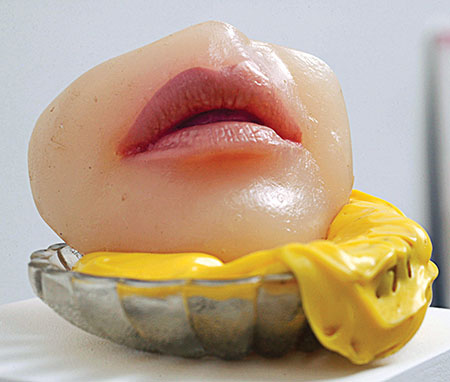Alina Szapocznikow

‘Sculpture Undone. 1955–1972’, one of the first large surveys of Alina Szapocznikow’s oeuvre outside her native Poland, boldly intends to establish the artist’s position in art history. The modest attention Szapocznikow’s work has received in recent years has often been overshadowed by her biography, which was scarred by experiences of war, concentration camps, poor health and an untimely death from cancer. As a consequence, her work has sometimes been narrowly interpreted through this lens, a condition that is diagnosed sensitively by the curators of the show at WIELS, which shifts attention towards the artist’s practice and the experimental dimension of her work.
The open plan of the exhibition’s first floor is thoughtfully designed to let the viewer capture the complexity of Szapocznikow’s practice in a single view. The youthful, nonchalant beauty of a classical female nude (Trudny wiek, Difficult Age, 1956) is juxtaposed with the disintegrated body of Ekshumowany (Exhumed, 1955), swaying at the verge of becoming a shapeless lump. A hybrid of human and machine parts, Goldfinger (1965) marks the artist’s interest in pop culture (its title was derived from the James Bond film of the previous year) and illustrates her art’s parallels with Nouveau Réalisme. The alluring Femme illuminée (Illuminated Woman, 1966–7), a cement silhouette with red breasts glowing seductively with electrical light, serves as a bridge to a second section of the show, in which sensual female figures emerge from the darkened space while the illuminated, biomorphic form of Caprice – Monstre (Caprice – Monster, 1967) blooms with eroticism. Nearby, playfully sexy lamps made of casts of lips and conceived as models for serial production reinforce Szapocznikow’s reflection on the female body but also on the work of art as a commodity.
If the somewhat orgiastic mood of this room might divert attention away from what is really at stake here – namely, the unorthodox character of Szapocznikow’s creative process – the next floor clearly articulates her use of innovative methods and materials, including casting in synthetic resin. The most experimental sculptures, made in poured polyurethane foam (a material reserved for industrial use at the time) stand in sharp contrast to more traditional bronze figures in a corresponding space on the lower level. Ostensibly abstract, dark forms embedded with cast body parts are shaped by a combination of the artist’s gesture and the chance inscribed in the unpredictable nature of the material. Gravity was an influential factor in the process of working with polyurethane, which is perhaps why the viewer’s gaze has to slide to the floor to see sculptures like the apocalyptic landscape of Grande Plage (Large Beach) or the uncanny Stela (Stele, both 1968) with a pale face and pair of knees peering out of a black substance. Hanging on the wall, the disturbing L’Enterrement d’Alina (Alina’s Funeral, 1970) combines bits of clothing and photographs of the artist and her friends encrusted under layers of resin formed in tumor-like shapes. In a subsequent gallery, located just above the sensual darkened room, a bright, almost laboratory-like light illuminates ‘Fetishes’ (1970–71), a collection of decomposing personal items frozen in resin and scattered on a flat surface like leftovers on a table.
Szapocznikow constantly returned to the body as a sculptural term, both as an object of restless pleasure and consumption, and as decomposed and abject, reminding us of its fragility and evanescent nature. The artist’s own body is almost always present in the exhibition: as a creative force, in self-portraits, or as fragments in a persistent process of remaking. But it disappears in the poignant work Piotr (1972), a figure of the artist’s son made shortly before her death. The piece resembles a traditional pietà, yet it lacks support – the mother’s body is missing. Szapocznikow reappears briefly in a documentary projected in a corridor leading to a room containing personal archival material, separated deliberately from the rest of the show. In the film, a journalist remarks to the artist: ‘You say nothing about yourself, but you expose yourself.’
‘Sculpture Undone’ successfully illustrates Szapocznikow’s persistent preoccupation with the sculptural medium. The act of ‘undoing’ of the show’s title is gradually revealed as the artist’s prolonged exploration of forms and materials, and is demonstrated through works that show her rigorous process. Elaborate drawings and prints displayed alongside the sculptures prove Szapocznikow’s meticulously academic approach and extraordinary attachment to craft; objects are preceded by precise studies; each shape results from a conscious decision. Commenting on her works in 1967, Pierre Restany wrote: ‘It will still take a long time for Alina to rip apart the anguish-ridden sails of her inner world. But the trigger has been pulled, and nothing will ever hinder this process.’ With ‘Sculpture Undone’, which tours to three American venues including New York’s Museum of Modern Art, a place for Szapocznikow within the canon of art history is firmly being made. The trigger has been pulled.















